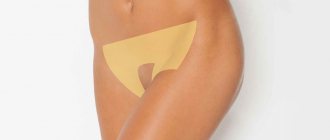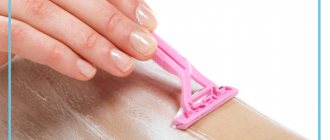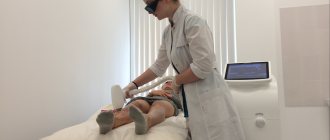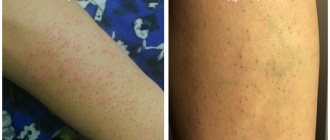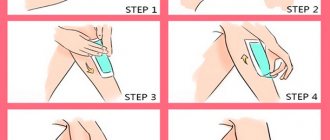Thanks to innovative cosmetic procedures, you can simply and effectively get rid of almost any external flaw. So, removing body hair with a razor today is almost the same as doing a manicure with a chainsaw. The problem of excess hair is successfully solved by laser hair removal, without the daily routine and unpleasant consequences such as peeling, blackheads, ingrown hairs and skin irritation. To learn more about this procedure, we turned to the head of the Moscow studios Soft laser , Delight Laser and Epilaserman Alena Kaygorodova. This salon uses the latest lasers with Iplaser technology. With them, the procedure is as comfortable as possible, and the devices themselves are suitable for almost all skin types. An experienced cosmetologist told how to prepare for laser hair removal and how to avoid becoming a victim of deception by unscrupulous clinics.
How does laser hair removal work?
In order for laser light energy to affect hair, the body must have special substances that would attract, absorb, and carry out a physical and chemical reaction. The main absorbent substance needed for laser hair removal is melanin. It is what gives color to hair and skin.
Melanin has 3 fractions: eumelanin, which is responsible for dark shades, pheomelanin, which is responsible for light shades, and neuromelanin, which is found in the structures of the brain. Ultimately, the predominance of one faction or another will determine the final shade of hair color. Only eumelanin has light-absorbing abilities. The remaining fractions reflect light, so epilation of light hair, be it light fluff, blond or gray hair, is impossible. For such people, laser hair removal is a waste of time and money. They are usually recommended to turn to other types of hair removal: depilation or electrolysis.
When light energy is absorbed by hair shafts containing melanin, various reactions occur in the subcutaneous tissues, the main of which is thermal. The hair is heated to a high temperature, which leads to the destruction of the follicle. Therefore, the process of light hair removal is called thermolysis (thermo - temperature, lysis - destruction), and from a scientific point of view, photo- and laser hair removal is correctly called photothermolysis (light-thermo-destruction). With photothermolysis, hair is heated to 70-80 degrees Celsius. All cells of the hair follicle die, including the cells of the hair papilla, so hair growth does not resume for a long time.
But, unfortunately, the structure of the follicle is regenerable, so it is impossible to permanently remove hair. You also need to understand that there are different phases of hair's life: the growth stage, the intermediate stage and the resting stage. Laser hair removal can only remove hair that is in the growth phase, as it is saturated with melanin. From 20% to 90% of the epilation zone is in the growth phase, so after about 2 weeks, hair loss occurs in patches. The transition from the sleep phase to the growth phase takes 21-28 days, which determines the interval between procedures for a maximum of 30-31 days.
But it happens that due to individual characteristics, the transition takes more than a month. In this case, a month after the procedure, you need to be guided by the hairs that appear: if they are there, then the transition has occurred and you can work.
Often, after 3-5 sessions, the follicle tries to replenish the lost bulbs and activates their maturation. This reaction is natural, it is called “paradoxical growth.” But this quickly passes with subsequent procedures. The main thing is to calm down, don’t panic and just continue the course.
What not to do after hair removal
Recommendations about what not to do after removal are most often the same for everyone. In rare cases, a cosmetologist may recommend an antihistamine. In the next 2-3 days after removal, experts recommend:
- wear light-cut clothes made from natural fabrics;
- do not visit the pool, sauna, gym;
- do not use scrubs and peels.
It is not recommended to sunbathe on the beach or visit a solarium for 3 weeks. It is necessary to use sunscreen.
How often to do laser hair removal with a diode laser depends on the growth rate of dormant hairs. The minimum break time is 20 days, the maximum can be up to 1 month. Complete removal of hair follicles takes on average 8-10 months and depends on the characteristics of the hair structure.
With each session, the amount of hair decreases noticeably, and the hair itself becomes thinner. At the end of the complex, you can forget about the problem area. In the future, you will need to periodically maintain the result once a year. Therefore, laser hair removal is considered the most effective.
Which technology has the best price/quality ratio?
Today there are dozens of lasers from different manufacturers. But they can all be reduced to several types: alexandrite, diode, neodymium, Elos, AFT, IPL and IPLASER. We only use lasers with the IPLASER system as they are safe, effective and painless. Our specialists are qualified physicians, as it is important to assess the risk and possibility of laser hair removal individually for each client.
Find out prices for laser hair removal
Advantages and disadvantages of the procedure
Any method of hair removal has obvious advantages, but it is not without its disadvantages. Laser hair removal is also bipolar. Let's weigh the pros and cons of laser hair removal.
pros
The advantages of light sessions include:
- Non-invasive. Superficial treatment of the area does not involve physical penetration under the skin. Thus, the risk of infection is reduced to zero.
- Comfort. If we compare other hair removal methods that promise a similar long-lasting effect, light hair removal is certainly more pleasant to perform. There is almost no pain.
- Speed. Working your arms from shoulders to fingertips will take about 20 minutes.
- Efficiency. A full course of laser hair removal really helps to get rid of hair for several years to come, and the subsequent growth of the fuzz can also be corrected by a cosmetologist.
Minuses
Among the disadvantages of the laser are a considerable list of contraindications, the possibility of undesirable consequences, as well as high cost and a long time period to achieve a complete “naked” effect. As for the impossibility of independently performing the procedure, this drawback is no longer relevant. Portable laser devices have appeared on the market of cosmetology equipment for home use. They have lower performance compared to professional equipment, but can still be useful in the fight against unwanted hair.
Which parts of the body can be removed with laser hair and which parts cannot?
Using a laser, you can remove hair from any part of the body, even on the labia of women, in the nose or ears. The exception is the eyes. Since the skin around the eyes is very thin, to avoid the risk of any damage or consequences, we do not epilate the hair under the eyebrows, but we can do it between and above.
Which hair is easier to remove permanently?
Initially, laser hair removal was performed on patients with a certain hair color: from light brown to black. In 2022, modern equipment allows you to work not only with dark, but also with light shades.
The problem is solved through different types of devices, as well as customization for a specific client. Nowadays laser hair removal works on both gray and red hair.
For true blondes, the process of getting rid of unwanted hair can take a long time. And dark-haired girls with a tan do not lose the risk of getting a burn. Both need to undergo a course of procedures to achieve a good result.
The optimal combination remains the same: the paler the skin, the darker the hair, the better the method works.
How many treatments are needed for complete hair removal?
This is an individual question. There are many scammers on the market who promise to do this in 6, 5 and even 4 sessions, but this is a trick to attract clients, nothing more. Yes, there are rare exceptions when girls’ hair disappeared in 4 sessions, but the probability of such a result is approximately 0.5%. More realistic numbers are 6-10 sessions. This is on average. This means that sometimes there are 12. We honestly warn our clients about this so that they are mentally prepared.
In addition, when the master tells you the exact number of sessions you need, this should alert you. In life, no specialist can say exactly how many sessions you will need for complete hair removal. One thing is the color, thickness and density of hair. Yes, we can consider them and assess the complexity of the case. But there are factors such as hormones and heredity, and no one can predict their behavior. And even if you take a bunch of expensive tests, there is no guarantee that the readings will not change after six months. So is hair growth.
How many sessions may be required?
The duration of the course depends on the parameters of the person’s skin and hair:
- Colors;
- Thickness;
- Structures;
- Current state.
The procedure may be delayed due to certain medications. The method is useless if the causes of sudden hair growth are:
- Hormonal imbalance;
- Disruption of the endocrine system.
The number of sessions required to achieve the effect is determined individually. On average, specialists offer from 6 to 20 hair removal sessions.
How to care for your skin between sessions?
What not to do before laser hair removal:
- depilate the selected area (waxing/sugaring/electric epilator) less than 30 days before the session. Because during depilation, the hair is removed along with the follicle, and we simply have nothing to influence;
- sunbathe 7 days before the procedure;
- use peelings and scrubs three days before the session.
What to do after laser hair removal:
- Avoid exposure to the sun or solarium for 7-10 days. If you are planning a vacation at sea, you can use sunscreen (minimum SPF50) and apply it every 3-4 hours to all areas of the body that were exposed to light. If possible, try to protect the treated areas from direct rays;
- in the interval between procedures, exclude any alternative methods of hair removal and depilation, except shaving;
- We expect hair loss from 10 to 21 days. We don't rip them out. You can only help them fall off with a washcloth or scrub.
No special cosmetics or care is needed. Like any cosmetic procedure, laser hair removal has contraindications. This:
- acute allergic skin reactions, in particular an allergic reaction to light - photodermatosis;
- exacerbation of chronic diseases (eczema, psoriasis, lichen planus, ichthyosis, atopic dermatitis, lupus erythematosus, scleroderma, bullous dermatoses, collagenosis, vasculitis, dyschromia);
- coronary heart disease and hypertension;
- herpes in the acute stage;
- dangerous varicose veins (anticoagulants should be stopped a month in advance);
- any benign and malignant neoplasms;
- acute infectious diseases;
- pregnancy and breastfeeding (lactation);
- We simply bypass moles, nevi, pigment and birthmarks, papillomas, retreating from them by 2-3 mm;
- if you have recently had botulinum toxin injections.
After Botox, Dysport, Xeomin, Relatox, various dermafillers and biorevitalizants based on hyaluronic acid, hair removal in injection areas can only be done after 2 months. This is due to the fact that any type of energy accelerates the breakdown of administered drugs. But in other areas you can epilate as usual.
Contraindications
- oncological diseases;
- diabetes;
- individual intolerance;
- dark skin;
- skin diseases in the acute stage;
- a large number of moles in the hair removal area;
- pregnancy and lactation - only after consultation with a doctor;
- damage to the integrity of the skin - abrasions, scratches;
- tattoos;
- HIV AIDS;
- neurological diseases;
- mental disorders;
- blood clotting disorder;
- progressive varicose veins.
Is there a risk of ingrown hairs, folliculitis or skin cancer?
There is no risk of ingrown hairs. Moreover, the laser gets rid of them too. If the hair is not too deep, then the light reaches it, the hair dies and gradually the skin pushes it to the surface. Depending on the severity of the case, these ingrown hairs can go away for a period of 1 to 8 months.
Folliculitis can have a bacterial, fungal, viral or parasitic etiology, but laser cannot cause it. However, if you have a disease, laser hair removal is not recommended, so as not to aggravate the situation. In this case, it is better to consult a dermatologist. We have such a specialist in our studio; the first consultation is free. Regarding cancer: this is one of the most common concerns. No, the laser does not cause cancer, its light is harmless, this is officially confirmed by Rostest. The laser uses infrared light, while skin cancer is caused by ultraviolet light. You are more likely to harm yourself by spending long periods of time in the sun or in a tanning salon than by having laser hair removal treatments. Moreover, it is held only once a month. Laser hair removal also does not affect internal organs, since the light does not pass so deeply - maximum to the lower layers of the epidermis.
Prices
Prices vary depending on the city and region, but not significantly. The cost depends on the device and method used, the number of flashes in one session, the area of hair removal and the number of sessions to obtain maximum effect.
List of approximate prices:
- neck area - from 1000 rubles;
- face - from 2000 rubles;
- armpit area - from 1000 rubles;
- full back - from 2500 rubles;
- abdominal area - from 1300 rubles;
- chest and décolleté - from 2000 rubles;
- legs - from 2500 rubles;
- hands - from 1300 rubles;
- buttocks - from 1300 rubles;
- deep bikini - from 1500 rubles.
The cost of one laser flash starts from 60 rubles. The number of sessions is determined by the coarseness of the hair and the degree of pigmentation. An experienced specialist can easily determine the duration of the course and the subsequent effect.
How to prepare for the first procedure?
Before the procedure, you need to shave the selected area. This recommendation is rarely given because most lasers require hair to grow to 3-5 mm. For ours, there is no need to do this, which is certainly more comfortable in everyday life.
If the client wants to remove hair above the lip or on the arms and has not touched it there before, then the specialist can remove the hair himself before epilation using an electric trimmer. Well, the most important thing is not to read horror stories, but to tune in to a positive mood.
Sign up for laser hair removal
How does hair loss occur?
Laser hair removal takes place in a specially equipped room. The technique is based on point pulses emitted by the device. The strength and wavelength are selected to affect the hair follicle: from 700 to 1000 nanometers.
The beam of light from the laser penetrates to a depth of about 0.2-0.3 cm, practically without injuring the epidermis. The melanin contained in the hair absorbs directional light, gradually heating up the temperature along the hair shaft and heats the follicle. The follicle begins to collapse, and the vessels stop feeding it. Those of them that are in the stage of active growth gradually die.
After about 14-20 days, part of the hair - from 5 to 30% - in the treated area falls out on its own. The “dormant” ones at the time of the procedure grow back within 2-4 weeks: they are removed during repeated sessions.
What should you beware of when choosing a salon?
First of all, I would like to open my eyes to what methods of fraud there are in this area.
First, the laser. Now many salons buy cheap Chinese LEDs, which are ineffective. Very often in such salons the prices for procedures are prohibitively low, for example 200 rubles for the upper lip. If this is not a promotion, but a regular price, then you should be wary.
Secondly, lasers have a part (the lamp or the handle as a whole) that needs to be changed. For example, in our laser the handle needs to be changed every 600-700 thousand flashes, since the lamp power drops, and with it the result of the procedure. But many unscrupulous salons neglect this and shine with “empty” lamps. The effect is the same as at home under a light bulb. Particularly cunning salons do the first 1-2 sessions with a normal laser so that the client sees the effect, and then, at the 3-4th session, they can do it with an “empty” handle. As a result, the person is convinced that the problem is in his characteristics, and not in the shortcomings of the equipment, because at first there was an effect.
Thirdly, unscrupulous salons carry out procedures despite clear signs that laser hair removal is not suitable for the client. One day a girl approached us with a request to rid her of the hair on her arms. She went to an expensive clinic for 1.5 years and did not get any effect. At first glance, everything became clear: she had white translucent hair. When we said that, in principle, no laser can treat such hair, she was shocked and said that she could already buy a car with the money she left at that clinic.
Or another case. A very dark man with black hair on his back, stomach and chest came. The master noticed that they were already growing stubble and asked what they were doing before. The client said that he had already gone to laser. The master suggested that there was probably only 1 session at most, because the hair was growing quite thick. But the man admitted that he had already done 15 sessions on Alexandrite in an expensive clinic. Most likely, in order not to burn the skin (Alexandrite can only remove hair on the skin up to the 4th phototype), they turned down the power to the maximum, but it was not enough to burn the hair. As a result, the man started our course from scratch. After the first session, the effect was immediately visible; about 99% of the hair that was in the active stage was gone.
Laser operating principle
Laser hair removal is one of the light methods of hair removal for a long period. Under the action of a narrowly directed beam of waves, an area of skin is heated, and along with it, the vegetation with which it is covered. The substance melanin, located inside the pigmented hair, is a kind of conductor of energy. The heat is redirected to the follicle and has a destructive effect on the fluff, which is in the growth stage. Gradually, the hair root becomes more and more unviable and ceases to produce fluff.
The laser hair removal technique is simple: the cosmetologist moves the nozzle of the device along the client’s arm in the direction from the shoulder to the fingers
What happens to the surface of the skin
Cosmetologists claim that laser hair removal procedures performed on healthy skin are harmless to the epidermis. The zone heats up for a matter of seconds, then cools down either using various cooling methods or naturally. The light beam acts specifically on pigmented hairs: the energy is converted into heat and attacks the root of the hair. This means that the irradiation itself occurs on the surface of the skin and is not invasive.
What is the laser hair removal technique?
Direct treatment of the hands with the device is not very different from epilation of other areas.
- The cosmetologist conducts an initial diagnosis of the skin condition and asks the client about health and well-being.
- If no contraindications are identified, the doctor gives precise instructions on preparing the area for the first laser session.
- During hair removal, the specific area and the expected result are again discussed: men sometimes prefer only to reduce the intensity of hair growth, while women expect complete removal of hair.
- The cosmetologist sets up the device: indicates the pulse frequency and wavelength individually for you.
- After you and the doctor have applied protective equipment (lenses or glasses) to your eyes, the cosmetologist begins to numb the surface of the skin and begin laser hair removal. The doctor supports your hand with one hand, and with the other directs the nozzle of the device onto the skin. Gradually, the cosmetologist moves down: from the shoulder to the fingers (the pain threshold is higher there).
- The whole session takes no more than 10–15 minutes, depending on the number of subzones and the method of pain relief.
About the sensations on your hands during the procedure
Laser hair removal can be considered a gentle method of hair removal - there is no sharp pain or severe burning sensation. So, ladies don’t have to compromise with their own comfort. There are several delicate areas on the human body, the epilation of which is more sensitive. The shoulder girdle, forearms and hands do not belong to them, but the phalanges of the fingers are at risk.
To ensure that the laser hair removal procedure is pleasant for the client, cosmetologists traditionally use anesthesia.
- Cooling compounds. Special cryogels and creams maintain low temperatures for a long time. So, when they come into contact with the skin, they slightly freeze it. The effect lasts for several seconds - exactly as long as necessary for laser treatment of the area. The cosmetologist pre-cools the composition in the refrigerator, then applies it to the epilation area with a wooden stick and moves the handle of the device directly over the gel. After the procedure is completed, the doctor removes the excess product.
- Local anesthesia. In cosmetology, compositions with lidocaine are used for a wide range of services (for example, Emla cream). Light hair removal is no exception. The doctor applies a cream or gel containing an anesthetic to the cleaned area, and after 30–40 minutes, treats it with the device. The disadvantage of this type of anesthesia is not only the forced pause during the session, but also the lack of natural temperature protection of the skin from burns.
- Progressive handles of the device. The newest devices already have built-in cooling solutions: either the laser nozzle is equipped with a cryo-head, or the nozzle sprays a cold composition directly onto the skin area being treated.
Emla cream contains lidocaine and is a universal pain reliever widely used in cosmetology.
All of the above remedies are suitable for numbing fingers. Keep in mind that immediately after the session, hands should be thoroughly washed with soap - the compositions should not come into contact with the organs of vision and breathing.
What zones are allocated for hand hair removal?
The laser hair removal method is designed to work as precisely as possible. Thus, the narrow nozzles of modern devices allow the cosmetologist to influence an area of skin with an accuracy of half a centimeter. Therefore, there is no need to work the entire arm from the shoulder to the fingers if this is not necessary.
- The following division of the hand into subzones is considered classic:
- shoulders (the area from the shoulder joint to the elbow).
- Forearms (distance between elbow and wrist).
- Brushes.
- Phalanges of the fingers and the line from the little finger to the bone of the hand.
- If the hair is uneven, the cosmetologist can treat any area on the hands separately. There is no need to touch neighboring areas not covered with fluff.
Types of lasers for hair removal
Cosmetologists have been using light technology for hair removal for several decades. Thus, the devices themselves are constantly being improved, and the hardware base of bona fide beauty salons is being updated. The main factors that determine the quality of laser operation are the length of the light wave generated by the device and the frequency of the pulses.
Ruby laser
The great-grandfather of modern devices produced a light wavelength of up to 700 nm at a rarefied pulse frequency. Thus, the potential audience of the device were only “snow whites” - people with an obvious natural contrast in skin and hair color. Today, ruby devices are considered obsolete.
Alexandrite laser
Progress allows the next type of lighting technology to achieve better performance: waves with a length of 750–760 nm at a frequency of up to 1.5 Hz. Such a laser can still be effective for people with fair skin and dark, intense hair. Today it is hardly used.
Diode laser and its subtypes
This type of equipment is the most in demand today. The device generates optimal wavelength (800 nm) and pulse frequency (up to 2 Hz, depending on the client’s needs). The diode device allows you not only to get rid of hair completely, but also to simply reduce hair on your arms, cure hypertrichosis and control the increased stiffness of stubble.
Read more about diode laser in the article - Diode laser hair removal: the whole truth about modern hair removal techniques.
The market for professional cosmetology equipment also includes related lighting devices: hybrids of photo and laser technology. An example is the well-known AFT hair removal. So-called advanced fluorescent technology collects unused light beams using infrared filters and re-uses them for hair removal purposes. This way, without increasing power and risks, the cosmetologist achieves the desired result. AFT technology has many fans: representatives of the lightest, Celtic phototype, as well as gray-haired clients.
Neodymium laser
Another miracle of modern cosmetology is the neodymium laser. It not only acts safely on very dark and tanned skin, but also has a therapeutic effect: it fights acne, smoothes turgor and helps heal dilated capillaries (the so-called stars).
The choice of hair removal device is of paramount importance not only to achieve smooth skin, but also to minimize possible risks. Choose only those beauty salons and hair removal offices that you are confident in their integrity. Don’t be shy to ask the cosmetologist about the device he uses. What are the laser performance? Is it possible to customize? Avoid ruby and alexandrite machines - today, smooth skin can be achieved using a more gentle diode and neodymium laser.
About the longevity of a smooth result
Beauty salons and hair removal clinics urge their clients to forget forever about the problem of unwanted hair on their arms. They are lying: permanent removal of vegetation using a laser is only possible in very rare cases. This requires a complete contrast in skin and hair color: the light impulse can be maximum, it has a detrimental effect on the follicle without the risk of skin burns. However, you must admit that there are few “snow whites” among us. Everyone else will have to periodically refresh the smoothness.
Why does hair growth continue?
To achieve the “naked effect” and consolidate the result of hair removal for a long time, you need to undergo a whole course of procedures - from 6 to 10 visits to a cosmetologist. Why? At the moment the laser treats the surface of the skin, only the hairs that are in the active growth stage are susceptible to attack. This is the fluff that has already moved 2–3 mm above the epidermis. However, hair is produced continuously by follicles, and the hair life cycle includes stable and dormant stages. In order to “catch” the right moment of hair growth, you need to work on the hair removal area according to a special schedule. Thus, gradually all emerging hairs are neutralized “at the root”, and clients achieve flawless smoothness of the skin.
During one laser hair removal session, light affects only those hairs that are in the active growth stage
That very moment
The success of the procedure largely depends on two factors: the correct individual hair removal schedule and how accurately the client adheres to it. If the laser acts on skin that has recently undergone deep hair removal, the effect will not be achieved: the hair roots are already mechanically damaged and will recover naturally over time. And if you are late with a visit to a cosmetologist, the session will be more painful: the longer the “tail” on the surface of the skin, the more it heats up from the laser effect.
Each person's hair growth rate is different. There are a number of factors that allow a cosmetologist to accurately determine the correct interval between sessions.
- Intense vegetation throughout the body. If the client has a luxurious mane, and the fluff above the skin looks like hard stubble, most likely, the protective function of his skin is very active. Thus, hair follicles are restored within 20 days.
- Hormonal issue. In the period immediately after puberty, pregnancy, menopause or other changes in the functioning of the endocrine system, hair growth is especially active. So, cosmetologists even recommend waiting until the start of the hair removal course. If this is not possible, the consequences of “rogue” hormones are simply taken into account by the cosmetologist, and the pause between hair removal sessions is reduced.
- Gender. Traditionally, in men, the restoration of the protective function of the skin occurs faster. This is due to the production of testosterone. Thus, laser hair removal is carried out for representatives of the stronger sex with a difference of 2–2.5 weeks.
How to Maintain Smoothness for Years
At the end of the hair removal course, the client can enjoy perfectly smooth, hair-free skin for 3 to 5 years. Men are less fortunate - after two years, light stubble begins to awaken. The function of the hair follicles begins to recover, and they produce a thin, barely noticeable fluff. Cosmetologists recommend refreshing the result with 2-3 sessions of laser hair removal. The roots of the hairs will be destroyed again, and the vegetation will not bother you for several years.
Only highly qualified specialists
Laser hair removal has long been used by a significant part of the population and is not a unique innovation. Its advantages are obvious, and due to its constantly decreasing cost, this service is increasingly replacing outdated methods of depilation.
However, in pursuit of a modern miracle, one should not forget about safety: you should not trust the first salon you come across to carry out this procedure. You need to make sure that the specialists are qualified and that the organization that offers this service has a medical license, and inquire about the presence of a registration certificate for the laser: this is a document that gives medical institutions the right to use the equipment on the territory of the Russian Federation.
Photo: epilas.ru
The EPILAS medical center, specializing in hardware cosmetology, operates in strict accordance with the requirements of the legislation of the Russian Federation, the Ministry of Health and Rospotrebnadzor. The procedures are performed only by highly qualified doctors and cosmetologists who have undergone mandatory professional training to work with laser equipment.
In less than a year of work, more than 10 thousand laser hair removal procedures have already been carried out here, and in the summer they promise to open a second center of a much larger area in Moscow.
As an advertisement
Possible side effects
In some cases, possible consequences may arise such as:
- redness, swelling, which does not need to be treated, they will soon disappear on their own;
- to avoid uncomfortable sensations, it is recommended to use cooling gels during and after the procedure;
- the appearance of traces of burns, which may occur if certain parameters of the procedure are not observed (processing time with one flash, incorrectly selected power mode);
- manifestations of pigmentation on the skin;
- exacerbation of dermatological diseases;
- folliculitis, in which the hair follicles become inflamed (often occurs with increased sweating or visiting a sauna or steam bath the day before).
Complications and consequences of laser hair removal
Side effects from laser hair removal
Watch a video about laser hair removal
